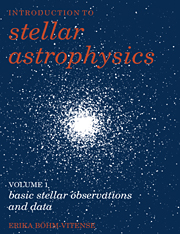Book contents
- Frontmatter
- Contents
- Preface
- 1 Positions of stars
- 2 Proper motions of stars
- 3 Distances of nearby stars
- 4 The brightnesses of the stars
- 5 Color magnitude diagrams
- 6 The luminosities of the stars
- 7 Angular radii of stars
- 8 Effective temperatures of stars
- 9 Masses and radii of stars
- 10 Spectral classification
- 11 Understanding stellar spectra
- 12 Population II stars
- 13 Stellar rotation
- 14 Stellar magnetic fields
- 15 Stars with peculiar spectra
- 16 Pulsating stars
- 17 Explosive stars
- 18 Our sun
- 19 Interstellar absorption
- Appendixes
- References
- Index
17 - Explosive stars
Published online by Cambridge University Press: 04 August 2010
- Frontmatter
- Contents
- Preface
- 1 Positions of stars
- 2 Proper motions of stars
- 3 Distances of nearby stars
- 4 The brightnesses of the stars
- 5 Color magnitude diagrams
- 6 The luminosities of the stars
- 7 Angular radii of stars
- 8 Effective temperatures of stars
- 9 Masses and radii of stars
- 10 Spectral classification
- 11 Understanding stellar spectra
- 12 Population II stars
- 13 Stellar rotation
- 14 Stellar magnetic fields
- 15 Stars with peculiar spectra
- 16 Pulsating stars
- 17 Explosive stars
- 18 Our sun
- 19 Interstellar absorption
- Appendixes
- References
- Index
Summary
Supernovae
Classification of novae and supernovae
The ancient astronomers had already noted that sometimes new stars became visible in the sky and after some time disappeared again. In the Middle Ages the astronomers called these stars novae, which is the Latin word for new stars. Some of these new stars were exceedingly bright, and were later called supernovae. Three of these supernovae were observed in historic times: Tycho de Brahe's supernova, which occurred in the year 1572, Kepler's supernova which became very bright in the year 1604, and a supernova which was observed by Chinese astronomers in the year 1054. At the location of the Chinese supernova we now see the Crab nebula in the constellation of Taurus. The nebula got its name from its appearance which reminds us of a crab. The Crab nebula still expands with velocities of about 1400 km s−1, showing that a truly gigantic explosion must have occurred 900 years ago.
What are these novae and supernovae? How often do they occur? What kinds of objects are their progenitors? What leads to such gigantic explosions? What distinguishes novae and supernovae? Are all supernovae similar events or do we have to distinguish different kinds of novae or supernovae? These are questions for which we would like to find the answers.
Both novae and supernovae are objects which suddenly increase their light output by many orders of magnitude.
- Type
- Chapter
- Information
- Introduction to Stellar Astrophysics , pp. 165 - 192Publisher: Cambridge University PressPrint publication year: 1989



